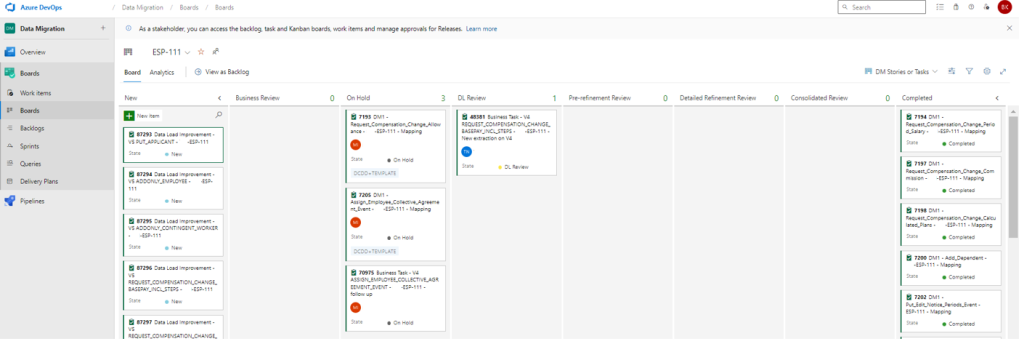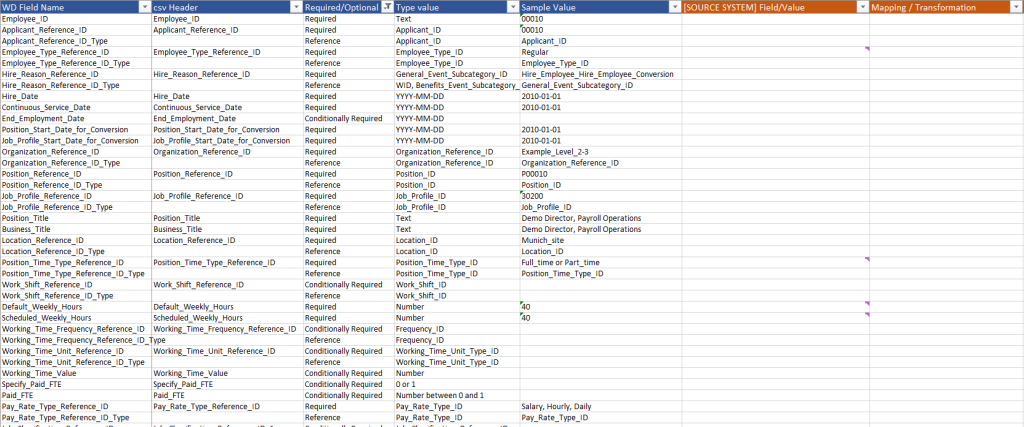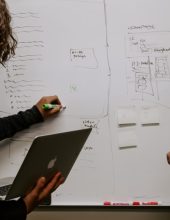Migrating data from an old ERP system to a new one is always challenging for organizations. The more employees and the more complex the company structure, the more time-consuming and costly the data migration can be. The role of the analyst, on whom the form and quality of the collected requirements and the selection of the data migration method to the new environment, remains invaluable in this process.
In this article, I will explain how the analyst’s work progressed and his role in a global data migration project from SAP’s HR module to the Workday system.
ERP Systems
At the outset, let us recall what systems such as SAP and Workday are in general. They belong to the ERP class systems, which are a collection of interrelated IT solutions that support the key processes of the entire enterprise. Nowadays, the practice of creating a single version of an ERP system for all customers is being abandoned.
ERP system providers, to remain competitive, consider that once the system is implemented, it will be customized according to each customer’s individual requirements. The need for ERP system customization arises from real and perceived imperfections in the functioning of the information system. Some of these deficiencies can be resolved by reorganizing business processes or reconfiguring the software, while others require customization of the system itself.
It is worth noting that there are also those deficiencies in the system solution that may never be completely remedied.
Any change to the initial solution must be re-validated each time the software package is implemented. In some cases, a complete system change is the best solution to eliminate system gaps as much as possible. As a result, as you can easily guess, ERP system customizations are a lengthy and costly process. It is an investment that will pay for itself for years, giving in return the possibility of optimized management of company resources.
Methods and tools to support data migration analysis
Let us then turn to tools that can prove indispensable during a migration project. They can facilitate team communication or provide secure storage for project documentation containing confidential data.
Azure DevOps as a tool for communication between teams
Azure DevOps is a Software as a Service (SaaS) platform Offered by Microsoft that uses its tools to connect developers, analysts, project managers, and other members of development teams to execute the deployment of new software or other solutions to facilitate communication and workflow in IT projects.
It is flexible enough to integrate with many popular tools on the market and is an optimal alternative to compiling DevOps-type tools. With its intuitive interface, organizations can deploy and improve products more efficiently than standard software development methods.
Azure DevOps can be accessed via a web browser or IDE client.
Azure DevOps tools
Azure DevOps core tools include:
- Boards – this is a set of tools to help plan and track the progress of deployments using agile methodologies such as Kanban and Scrum. It is a solution that, in data migration projects, also facilitates communication between teams. Moving a task to the next stage or team is done by simply ‘drag and drop’ with the mouse. In addition, most of the key activities of a data migration project will take place on so-called ‘Boards,’ as will be described in the following sections of this article.
- Other available tools such as:
- Repos – gives access to Git repositories and Team Foundation Version Control (TFVC) server for code source control.
- Pipelines –a set of tools for setting up automated processes for building and delivering applications.
- Azure Test Plans – provides tools for testing solutions, including exploratory testing and User Acceptance Testing (UAT).
- Azure Artifacts – with this solution, teams can access packages such as Maven, NuGet, NPM, etc., from public and private sources.

Sharepoint
The Sharepoint application provides a secure environment for collecting, organising and sharing information, allowing access from any device. You only need a web browser, such as Microsoft Edge, Internet Explorer, Chrome, or Firefox, to use this application.
Analysis of the data migration process
The data migration process that takes place in the described project has been defined as shown below:

According to the diagram above, the process starts with data extraction from the old database system. In this case, it is SAP HR. This can be done in two ways.
- The first way is manual data extraction, where employee data or part of it is in systems other than SAP or on the side of external companies, as in the case of payroll data. Here, data collection is carried out using pre-prepared templates that contain the relevant columns indicating the required values that should be included. In other words, in this approach, we create a manual list of employees with information about their employment conditions.
- The second approach is automated extraction. In this approach, templates are also filled in. Still, general rules and principles are written in, describing the tables from which the data will be drawn and the possible data mapping, translating the values from SAP into Workday’s language.
The next step is to send such prepared data to the development team, which is responsible for testing the rules and mappings provided by the templates or checking the correctness of the manual data. If the tests come out correctly – which I know from experience happens very rarely 😊 – the developers start uploading the data to the new system.
Preparation of templates
The first step towards gathering the requirements from the various local teams is to prepare templates containing all the necessary information regarding which data and tables should be transferred from the old database to the new one.
We will use the fairly common Excel as a tool, where each value will have a corresponding field. In addition, it will be possible to add a possible mapping in the tabs, which can be used to translate the values from SAP into Workday’s language.
Filling in the templates is a crucial step, as the better the data quality and mappings provided, the smoother and faster the entire migration will go. In addition, correct template filling will also reduce unnecessary bugs or the need to create Change Requests, which can significantly prolong the migration process. In addition, all templates are stored in their respective folders on Sharepoint, allowing easy access to all project documentation and allowing several people to work on the same file at the same time.

Preparing for migration
A key element of business analysis in a data migration project, as in other such projects, is close contact with the business, i.e., with the employees of the departments that use employee data in their daily work to administer them or pay salaries. Therefore, the team in such a department should be made up of people experienced in working with the old ERP system to resolve any errors quickly and efficiently. Technical people involved in implementing the old system will also facilitate the work and the acquisition of the necessary information.
Kick-off
To start working with stakeholders on the business side, a launch day is set for the entire project, where the first meeting, i.e., the Kick-off, will discuss the project’s goals, how it will be implemented, and the timeline. It is worth mentioning that the detailed preparation of the presentation and the templates on which the team members will work will significantly facilitate further cooperation. In other words, the more understandable the entire project and its objective are to HR professionals, the better-quality data we will receive.
Azure DevOps can prove to be an indispensable tool at this stage. Using the Board assigned to a particular stakeholder, we can create shuffles for individual templates, making it easier to monitor the progress of tasks and communicate between participants. Nevertheless, ensuring each participant has properly assigned access is very important. If they are not, assigning accesses can waste valuable time preparing templates.
Review and completion of templates
Let’s imagine that we are already after the kick-off; the stakeholders know why, for what purpose, how, and when the project will be implemented. What’s next? As a rule, the next step is a two- or three-week review and filling in the templates with relevant values. What does the Analyst’s job look like here? You could say that every country is customary 😊
- Some stakeholders place a very high value on working closely with the Analyst, who guides them through the process and is present when the templates are filled in. This is a method that very much speeds up the whole process, as the verification phase by the Analyst then takes place on the job. The HR representatives can ask questions directly, and the analyst can check that the team is entering the right values and creating the correct mapping.
- Another method used by some stakeholders is to work independently, which means that the stakeholder only consults his or her progress with the analyst in weekly meetings, and we, as analysts, can only inquire about the progress during the implementation or check the progress on the board in AzureDevOps. However, we don’t have direct control over how the task is completed as in the first collaboration model.
Refinement team
Two or three weeks have passed, and the stakeholders have provided us with documentation with the necessary values and data mapping. Assuming that the Analyst has supported the stakeholders in data collection, the next step is to assign tasks to the Refinement team.
This is a team of developers who, with the help of tests performed on the relevant environments, check that the values received from the process participants are working correctly. To signal to the Refinement team that they can start their work, giving the tasks on the board in Azure DevOps the appropriate status is sufficient.
So-called Refinement Sessions follow this analysis. These are meetings, organized by the analyst, where representatives of the Refinement team can present their test results directly to the HR team. The analyst facilitates the entire meeting and should ensure the meeting is consistent and effective. In addition, the Refinement team can leave their comments and questions for the individual template in shuffles in Azure DevOps. With this solution, all stakeholders can prepare for the meeting and review the results of their work again.
Upload of the exported data
Once all contradictions have been clarified between the teams, the data is ready to be sent to the development team, who will initiate uploading the exported data to Workday. To do this, the analyst must create a User Story in Azure for each template to collect and summarise all the necessary information needed for a correct upload. In addition, during the data transfer, the analyst supports the development team in any defects that may occur.
As you can easily see, the analyst’s role in such a large project is very broad and accompanies the many teams involved in the project at virtually every stage – from the kick-off to the final upload of the data.
Summary
Data Migration and Business Analysis in Data Migration is a highly complex process and is prone to possible errors occurring during implementation. Therefore, introducing the Analyst to the project is a time-consuming stage, as one has to familiarise oneself with how data is captured, including templates, communication between teams (HR, Developers, and with his/her team), or understand what data is required for each team.
Certainly, familiarity with the ERP systems between which the migration is taking place will make preparing the data and addressing the HR team’s concerns significantly easier. However, the knowledge an analyst has to assimilate in a global project will take time to efficiently and flawlessly acquire and analyze the database resources entrusted to him.
This will certainly be a rewarding and interesting experience for him, as the environment in which he will be operating is very dynamic and diverse, and a successfully implemented ERP system will be an interesting item in his experience as a specialist.
In addition, thanks to the tools presented in the article above, the migration can go more smoothly and efficiently, reducing the errors and misunderstandings that can occur during inter-team collaboration.
Bibliography
- Azure Microsoft
- SharePoint Microsoft
- Tomasz WASIELEWSKI, Robert KAMIŃSKI, Ireneusz J. JÓŹWIAK, Analysis of the Concept of Changes in ERP-class Information Systems, Zeszyty Naukowe Politechniki Śląskiej, Seria: Organization and Management, z. 113.
***
If you are interested in the role of an analyst or any other position in IT, be sure to see the career path articles prepared by our specialists.
***
Author of the translation: Igor Dziubiński
















Leave a comment